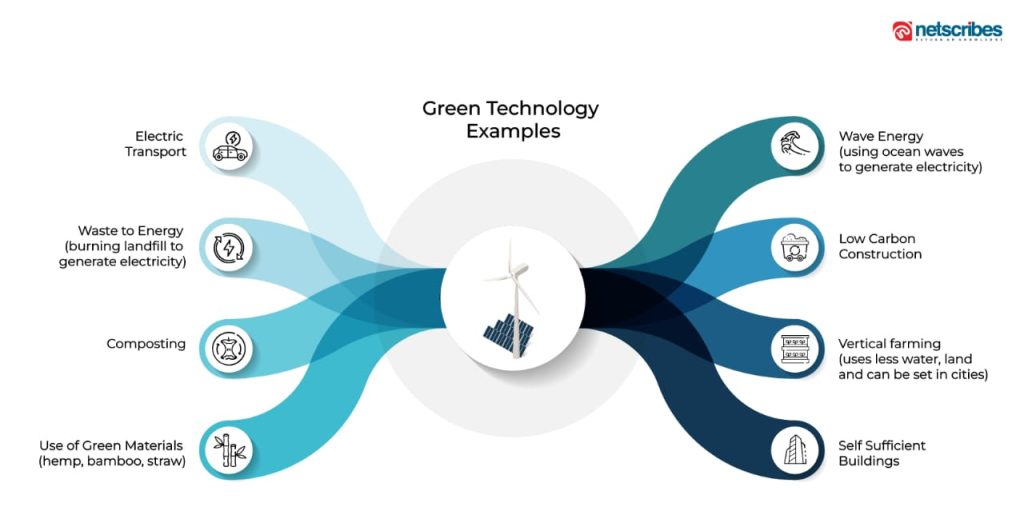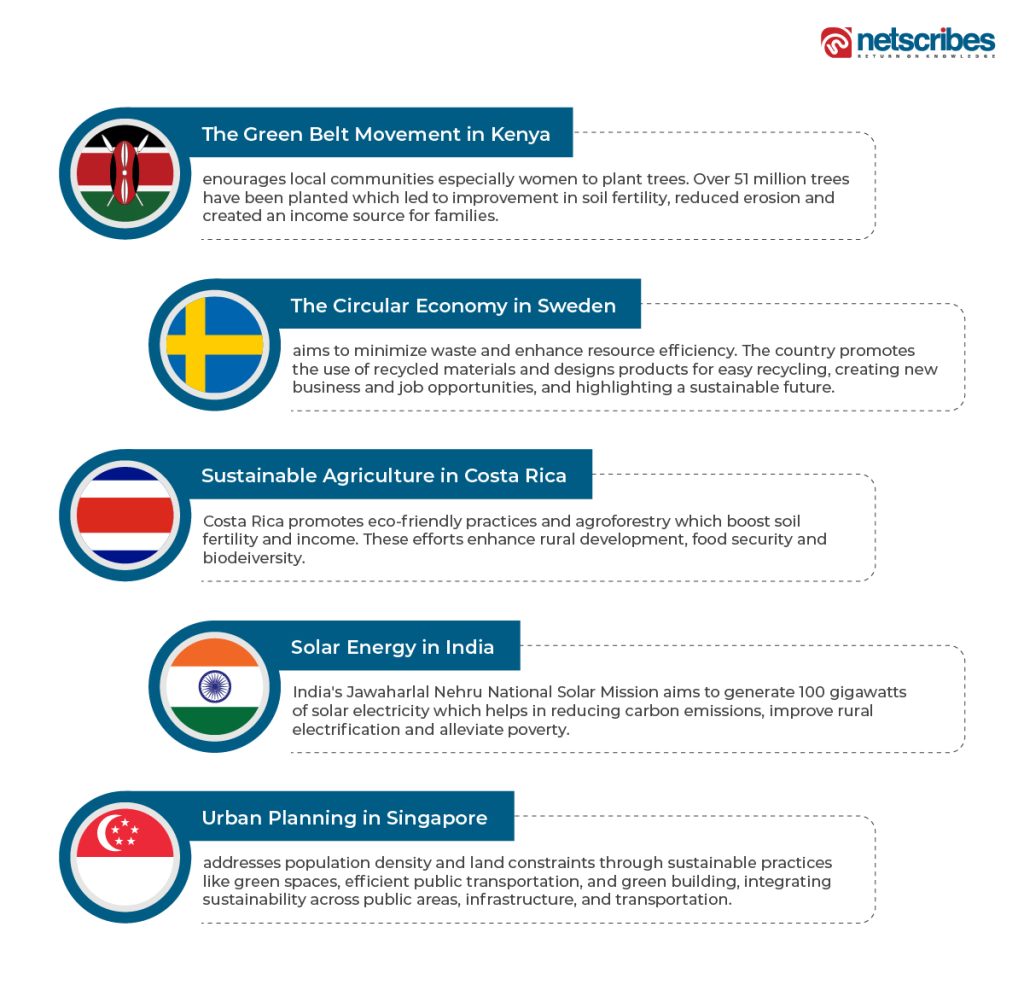Sustainability technology trends: Innovations in green development for a sustainable future

Gone are the days when sustainability initiatives were nice to have corporate social responsibility initiatives. Businesses worldwide recognize that sustainability is a must-have component in their strategy for growth. With the adoption of Sustainable Development Goals, the public and private sector players work in synergy to achieve sustainable development. Technological innovations in renewable energy, AI and ML, and EV sectors support the quest for sustainable development. This article explores the key sustainable technology trends and innovations shaping the future of a greener economy.
What is sustainable technology?
Sustainable technology fosters efficient use of resources to reduce negative impacts on the environment. It aims to drive positive environmental, social, and governance outcomes. Additionally, It chooses to use biodegradable materials and renewable energy for production. Sustainable technology also focuses on optimizing business operations and customer interactions, contributing to a healthier planet and society. By adopting sustainable technology in all aspects of their operations, businesses can contribute to society in a better way while also enhancing their growth prospects.
Emerging sustainable technology trends
1. Green technology – Renewable energy generation, storage and carbon capture systems are the key sustainable technology trends. It helps transform urban planning, water and waste management, and monitoring the air quality. For instance, GreenCoLab is an initiative by The Centre of Marine Sciences. It aims to drive innovation in algae biotechnology, utilizing biotechnological techniques for valuable production and environmental purposes. Some of the major sustainability technology innovations in the green technology segment are shown in the figure below.

2. Sustainable finance & investment – They are gaining popularity due to an increased focus towards eco-friendly projects and socially responsible initiatives. Investors and financial institutions are beginning to understand the importance of considering sustainability while making decisions. Innovative financial products such as green bonds, social impact bonds and sustainability-linked loans ensure appropriate funding for projects with positive environmental and social impacts.
3. Circular economy focus – It focuses on recycling and the development of a better product lifecycle which can be reused, repaired, or remanufactured. This approach helps in efficient waste management and promotes sustainable habits. Major cities worldwide are shifting towards a sustainable circular economy model. For instance, The city of Amsterdam wants to completely shift to a circular economy by 2050. They want to make food supply chains shorter, and encourage people to buy things that last longer. With this, Amsterdam aims to cut down on overall consumption by 20%. They also intend to encourage builders to use materials in a more circular way. They are also working with businesses to promote recycling and reusable materials.
4. Evolving customer expectations – Consumers favour the brands who adopt ethical and environment friendly strategies in their business models. Customers expect their brands to be transparent and responsible. They want the brands to offer quality, behave ethically and contribute towards society and environment. They expect companies to be transparent about the product development, packaging and wase disposal process.
5. Changes in regulations & carbon pricing – Governments worldwide have started prioritizing climate. They are implementing strict rules and regulations to reduce greenhouse gases emissions. The goal is to move towards a low-carbon economy. One example is the Paris Agreement which focuses on creating a framework that promotes co-operation and co-ordination among countries. The Sustainability Develeopment Goals 2030, or shortly SDG2030, is also a major global initiative by the United Nations. It aims to achieve sustainability in all walks of life to ensure peace and prosperity to people and the planet. Carbon pricing involves associating a monetary cost on greenhouse gas emissions. This encourages businesses to control the level of emissions from their operations.
6. Integration of AI & Big Data – By analyzing large datasets, AI can recognize patterns, optimize processes, and identify future maintenance needs. Advanced analytical tools powered by AI and ML are helping decode environmental impact. They can also analyse energy output, optimizing system performance, and improving maintenance through predictive analysis. AI can be a huge differentiator in the management of smart grids. It can help utility companies manage power grids efficiently by accurately predicting energy demand and supply, thus reducing energy wastage.
7. Emergence of sustainable supply chains – A sustainable supply chain fully integrates ethical and environmentally responsible practices into a competitive and successful model. Truly sustainable supply chains extend beyond last-mile delivery to cover product returns and recycle processes as well. Digital supply chain technologies are facilitating the emergence of sustainable supply chains. Further, Big Data management, advanced analytics, AI, and security tools such as blockchain and RFID sensors are increasing the security and transparency of supply chains. Companies have started recognizing the need for sustainable supply networks to create a positive impact on the environment. In December 2021, the G7 announced the formation of the Sustainable Supply Chains Initiative (G7 SSCI), which includes 22 international food and agribusiness corporations with the intention to change food systems and advance global progress toward the Sustainable Development Goals.
Sustainable technology innovations
Sustainable technology trends and innovations are important for addressing environmental issues, promoting global collaboration, job creation, resource optimization, and reducing greenhouse gas emissions, thereby ensuring a fair and sustainable future.
1. Advancements in renewable energy – Renewable energy sources , such as solar cells and panels, wind turbines, and offshore wind farms, combat climate change by producing power without depleting precious natural resources and emitting damaging greenhouse gases. Renewable energy is now more dependable and useful in daily life because to its integration with smart grid technologies and energy networks. For instance, the 16-mile Oresund Bridge linking Denmark and Sweden is an environmentally friendly construction project that uses energy-saving lighting and wind turbines.
2. Electronic vehicle (EV) and transportation – Increase in the production and demand of EVs shows a significant shift towards cleaner and green modes of transportation. Customers are choosing electric cars due to their long-lasting, high capacity and fast charging batteries. They help reduce air pollution and lower carbon emissions which in turn helps our environment. Cities are introducing electric buses, trams, and trains to modernize their public transportation. Nirmala Sitharaman, the honourable finance minister of India, proposed an initiative in the Interim Budget 2024-25 focusing on enhancing EV manufacturing, charging infrastructure, and public transportation, particularly electric buses.
3. Green building and low-carbon construction – These are eco-friendly alternatives for traditional construction materials, which can help improve energy efficiency and sustainability of buildings. Recycled materials, renewable resources, and energy efficient designs are some of the eco-friendly innovations used in the construction industry. For instance, Masdar City is a carbon-neutral city in Abu Dhabi. It is powered by renewable energy and uses rainwater harvesting and solar streetlights. With a goal of 70% less energy consumption than traditional cities, Masdar City is a valuable experiment in sustainable development and could serve as a model for other cities.
4. Smart farming – Sustainable agriculture techniques will be an essential part of the initiatives to reduce the negative impact on the environment in the coming years. Today, drones and satellites help monitor the crops and AI analyses data for resource optimization. Moreover, extensive use of smart farming techniques like Aquaponics (water-efficient method of growing crops) and regenerative agriculture is increasing food production in a more sustainable manner. Crop rotation, cover cropping and agroforestry techniques help capture and store atmospheric carbon dioxide, thus improving soil health.
5. Waste management solutions – Managing waste in an efficient and sustainable manner is another key area that is being focused on. New recycling technologies to sort, clean and process waste are gaining wide adoption. Use of IoT technology has further developed the smart bins which use sensors to optimize waste collection process. For instance, Indore, India’s growing city, has become a leader in sustainable waste management by implementing a comprehensive system supported by suitable policies, revamping infrastructure, and engaging with the community to create an efficient, eco-friendly approach.
Read more: The impact of new energy trends on global waste management: A synergistic approach
6. Carbon capturing and renewable energy storage – Removal of Carbon from the atmosphere directly is a necessary step towards reversing global warming. Capturing carbon from the atmosphere and storing it is a technique which is currently low scale and expensive but is predicted to be highly scalable in coming years. Ensuring the availability of renewable energy even during the non-availability of sunlight or wind is a crucial need. Many companies like Matla and Aquion Energy are focused on developing long-term storage solutions for green energy.
Initiatives by governments for sustainable development
The United Nations’ Sustainable Development Goals (SDGs) provide a framework for countries and organizations to work towards sustainable development, focusing on seventeen key areas: poverty eradication, clean energy, sustainable cities, and responsible consumption. Some of the examples have been mentioned below:

Conclusion
By 2030, nations, business enterprises, and local communities worldwide aim to enhance sustainability in governance, social impact, and economic growth. Businesses are incorporating sustainable practices into their strategies by lowering energy consumption and adopting renewable energy sources. Corporate programs aim to include goals like paying fair wages, ensuring safe workplaces, and giving everyone the same chances at work. Reducing carbon emissions, promoting inclusivity and diversity in the workplace, increasing accountability and transparency in governance, and successfully involving communities are some the key objectives in the drive to promote sustainability. Technology is the key enabler of these sustainability initiatives. AI helps optimize irrigation and energy grid management, while blockchain maintains supply chain integrity. The importance of sustainable technology trends is growing, and new tools and technology are helping businesses accomplish their goals. Case studies from nations such as Singapore, Kenya, Sweden, India, and Costa Rica demonstrate the significant influence of sustainable development.
Explore our technology solutions today.
This blog has been written by Prerna Agarwal, Senior Research Associate, Research Team






